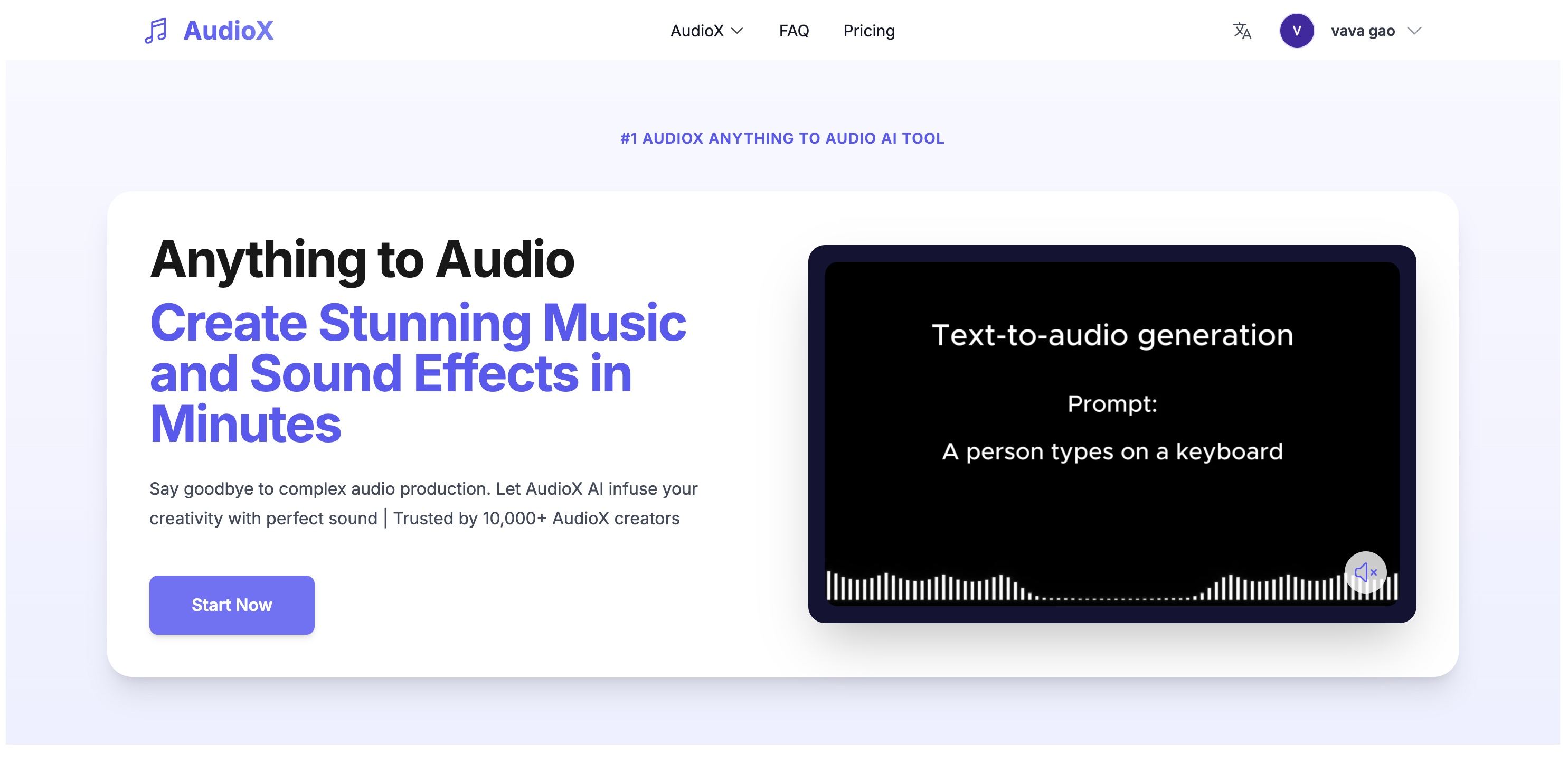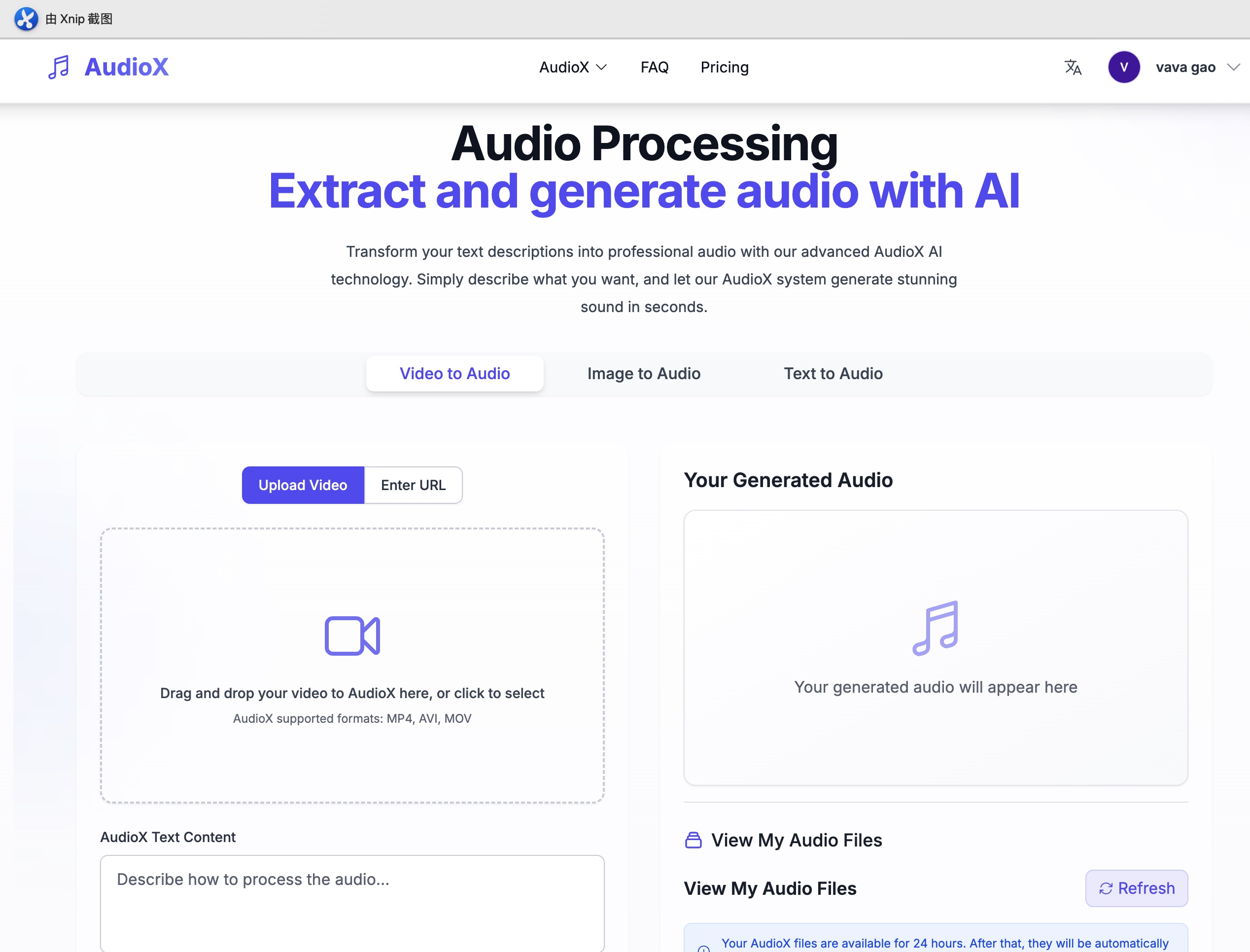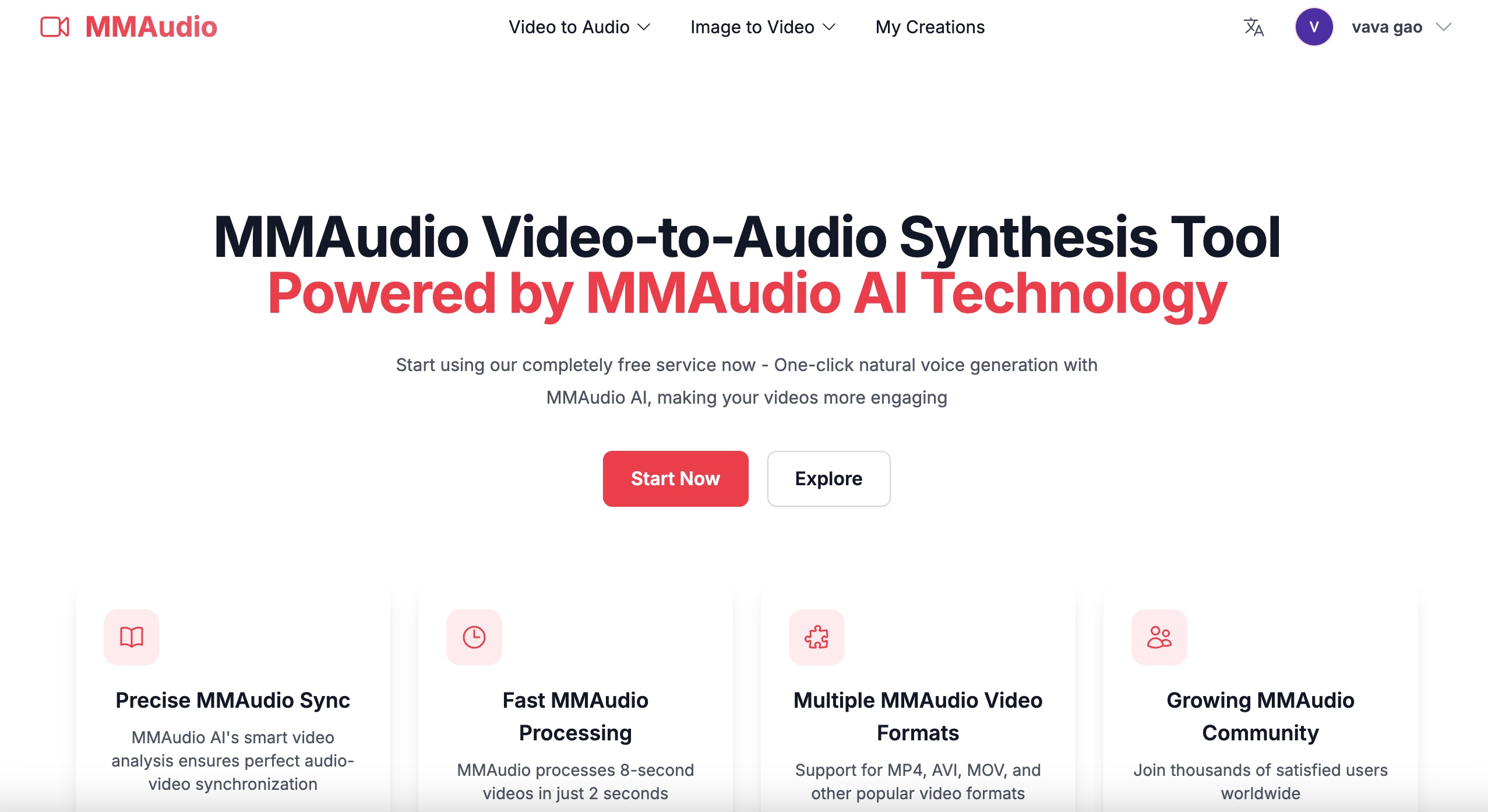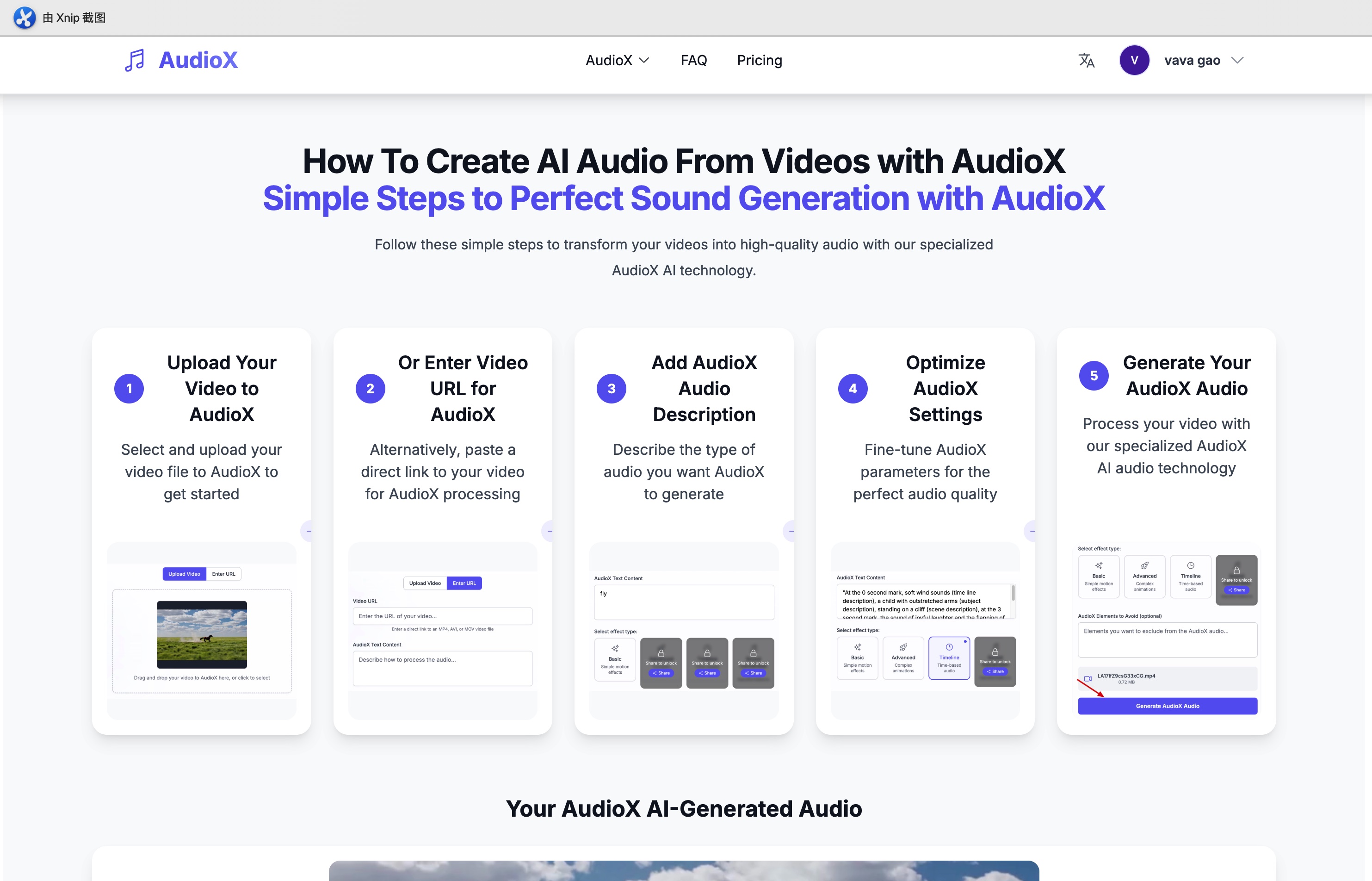
Introduction
The landscape of audio production has been transformed by the emergence of powerful AI technologies. Two platforms at the forefront of this revolution are AudioX and MMAudio, each offering innovative solutions for creators looking to generate professional-quality audio. While both platforms leverage sophisticated AI algorithms to democratize audio creation, they differ significantly in their approach and capabilities. In this article, we'll explore the key differences between AudioX and MMAudio, helping you decide which platform best suits your creative needs.
AudioX: The Complete Multi-Modal Audio Generation Platform

AudioX stands out as the more versatile platform with its "Anything to Audio" approach, offering a true multi-modal experience that can generate professional audio from virtually any input:
Text to Audio: Perfect for when you have a specific sound in mind but lack the musical skills to create it. Simply describe what you're looking for—whether it's "an emotional piano piece with building strings for a dramatic scene" or "upbeat electronic dance music with strong beats and synth melodies"—and AudioX will generate matching audio in seconds.
Image to Audio: This innovative feature, unique to AudioX, analyzes the visual elements, colors, and mood of any image to create perfectly matching audio. Upload a serene landscape, and AudioX might generate calming ambient music; share an action-packed scene, and it could produce energetic, dynamic audio.
Video to Audio: AudioX can analyze video content and generate synchronized soundtracks that perfectly complement the visual narrative. This is particularly valuable for content creators who need matching background music or sound effects for their videos.
MMAudio: Specialized Video-to-Audio Technology

MMAudio takes a more specialized approach, focusing exclusively on transforming video content into audio:
Video to Audio Synthesis: MMAudio's core strength lies in its ability to generate audio that perfectly matches video content. The platform excels at creating synchronized soundtracks for videos, using advanced AI to analyze visual cues and generate corresponding audio elements.
Fast Processing: MMAudio offers impressive processing speeds, taking just 2 seconds to process an 8-second video, making it efficient for quick video soundtrack generation.
Multiple Format Support: The platform supports popular video formats including MP4, AVI, and MOV, with file sizes up to 10MB.
Key Differences: AudioX vs MMAudio

When comparing these two platforms, several key distinctions emerge:
Input Versatility:
- AudioX: Supports text, images, and videos as input sources
- MMAudio: Focuses exclusively on video inputs
Unique Capabilities:
- AudioX: The Image to Audio feature is exclusive to AudioX, allowing for creative audio generation from static visuals
- MMAudio: Specializes in video-to-audio conversion with highly optimized processing
File Support:
- AudioX: Offers graduated file size support based on subscription tier, up to 100MB (Professional) and unlimited (Enterprise)
- MMAudio: Limited to 10MB file size across all user levels
Processing Approach:
- AudioX: Uses a comprehensive audio generation system with over 30 music styles
- MMAudio: Employs specialized CLIP and Synchformer technologies optimized for video frame analysis
Use Cases: When to Choose Each Platform
When AudioX Shines:
Creative Exploration: When you want to generate audio from different types of inspiration (text descriptions, images, or videos)
Visual-to-Audio Translation: When you need to create audio that captures the mood and atmosphere of still images
Complex Projects: When you require more extensive editing capabilities and multi-track generation
Larger Files: When working with higher-quality or longer-form content that exceeds 10MB
When MMAudio Excels:
Quick Video Soundtracks: When you need fast, efficient audio generation specifically for video content
Synchronization Focus: When precise sync between video and audio is the primary concern
Simpler Workflow: When you prefer a more streamlined, specialized tool focused on one specific task
Open Source Preference: When you value open-source technology and continuous community improvements
Technical Comparison
AudioX Technical Advantages:
Multi-Modal Input Processing: AudioX's ability to process different input types through a unified AI system demonstrates more versatile deep learning architecture.
Emotional Intelligence: The platform's ability to analyze emotional qualities across different input formats shows advanced contextual understanding.
Scalable Processing: AudioX offers tiered processing capabilities, with faster speeds available to Professional and Enterprise users.
Creative Exploration Tools: The platform includes advanced features for generating variations and blending styles, demonstrating more sophisticated audio composition capabilities.
MMAudio Technical Advantages:
Frame-Level Video Analysis: MMAudio's specialized CLIP model operating at 8 FPS and Synchformer at 25 FPS shows dedicated optimization for video processing.
Efficient Processing Pipeline: The platform's ability to process video quickly indicates a streamlined, purpose-built architecture.
Open Source Foundation: Being built on open-source technology allows for continuous improvement and community contributions.
Pricing and Accessibility
AudioX:
- Offers tiered subscription models (Starter, Professional, Enterprise)
- Provides free trials with limited generations per day
- Scales features and capabilities based on subscription level
MMAudio:
- Offers free trial access
- Simpler pricing structure focused on video processing capabilities
- File size limitations remain consistent across pricing tiers
What Users Are Saying
AudioX User Feedback:
Emily Chen, YouTube Creator: "Since using AudioX, my video engagement rate increased by 32% and follower growth rate doubled. The ability to generate audio from both my video content and promotional images gives me incredible creative flexibility."
Michael Rodriguez, Music Producer: "AudioX completely changed my creative process. Being able to generate audio from text descriptions and images gives me new starting points I wouldn't have discovered otherwise."
MMAudio User Feedback:
Wang Xiaoming, Content Creator: "MMAudio's Video-to-Audio Synthesis is perfect for my workflow. The processing speed is impressive, especially for quick video projects where I need matching audio fast."
Professor Li, Research Scientist: "MMAudio's precise synchronization makes it invaluable for my research projects. The open-source nature of the technology aligns with my academic values."
Conclusion: Choosing the Right Platform for Your Needs

Both AudioX and MMAudio offer powerful AI-driven solutions for audio generation, but they serve different needs and workflows:
Choose AudioX if:
- You want the most versatile "Anything to Audio" platform
- You need to generate audio from text, images, and videos
- You work with larger files and more complex projects
- You value extensive creative control and editing capabilities
Choose MMAudio if:
- Your focus is specifically on video-to-audio conversion
- You prioritize processing speed for video soundtracks
- You prefer specialized tools optimized for a specific task
- You work primarily with smaller video files
The ideal choice ultimately depends on your specific creative needs, workflow preferences, and the types of projects you typically handle. For many creators, AudioX's comprehensive "Anything to Audio" approach provides greater versatility and creative possibilities, while MMAudio offers a streamlined solution for those focused exclusively on video-to-audio conversion.
Whichever platform you choose, both AudioX and MMAudio represent the exciting future of AI-powered audio creation, making professional sound more accessible than ever before to creators of all skill levels.